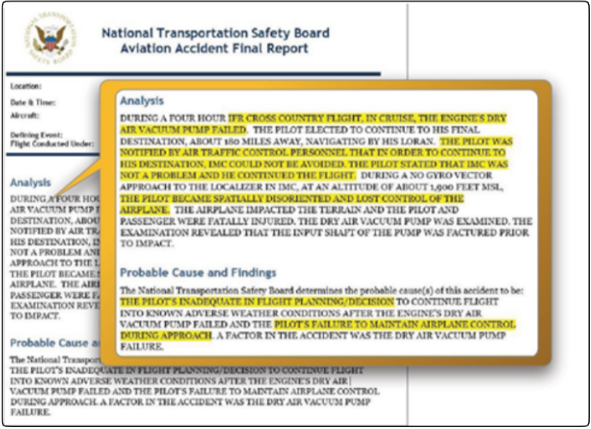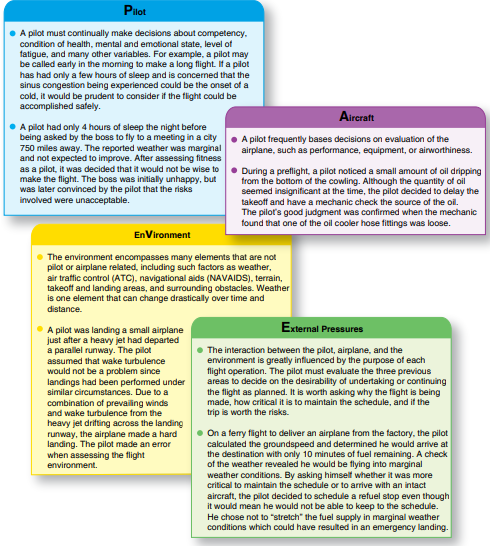Introduction
Pilots experience the joy of taking an aircraft and passengers on flights that are visually pleasing and productive. However, most pilots also know people who have had accidents or died while flying.
By following the principles discussed in this handbook, pilots can:
- Make safety of flight their top priority.
- Fly with confidence.
- Enjoy each trip to the fullest extent possible.
Safety Management Systems in Aviation
This Risk Management Handbook focuses on the individual and not on safety management systems (SMS). SMS addresses risk management from an organizational perspective as an ongoing activity. Interested persons may obtain information about SMS here.
Accident Causality & Responsibility
Both the National Transportation Safety Board (NTSB) and the Federal Aviation Administration (FAA) investigate aviation accidents. The NTSB determines the probable cause(s) of accidents and makes recommendations, while the FAA determines if accidents reveal deficiencies in pilot training, aircraft certification, air traffic control, or other areas of FAA responsibility. During accident investigations, the two government entities usually receive assistance from other interested parties, such as aircraft manufacturers and operators.
A review of the following accident report illustrates the role of the NTSB. The sidebar in Figure 1-1 is an excerpt from an NTSB final report of a fatal accident involving a single-engine airplane with a reciprocating engine.

Figure 1-1. Sample NTSB final report.
Key findings of the NTSB aviation accident final report, highlighted above in yellow, emphasize the pilot’s inadequate in-flight planning/decision to continue flight into known adverse weather conditions after the engine’s dry air vacuum pump failed and the pilot’s failure to maintain airplane control during approach. The NTSB report, available here, also contains information about this pilot’s decision-making and risk management.
Many incidents and accidents occur as a result of poor risk management. The following accident review illustrates the importance of risk-based decision-making, as a means to prevent a negative outcome.
Risk Management Analysis Using the PAVE Checklist
The accident described above contains risk factors included in the PAVE checklist. As shown in Figure 1-2, the acronym “PAVE” represents hazards that relate to the pilot, the aircraft, the environment, and external pressures. The sample analysis below describes how PAVE items may relate to the accident.

Figure 1-2. The PAVE checklist.
The pilot reported to air traffic control (ATC) that the vacuum pump failed while in visual meteorological conditions (VMC). As a result, the attitude indicator and directional gyro became inoperative. Rather than divert to an airport while in VMC, the pilot decided to continue toward the destination and into instrument meteorological conditions (IMC). This elevated the risks associated with an “A” hazard because of the inoperative instruments and a “V” hazard because of the IMC. After the vacuum pump failure, the pilot communicated with ATC that IMC would not be a problem, which may indicate a hazardous attitude or “P” hazard. It is unknown if an external pressure or “E” hazard factored in the pilot’s apparent desire to get to the destination.
In this case, the pilot had the opportunity to change the outcome of the flight by diverting to an airport while still in VMC. Several reasons explain why pilots do not make appropriate decisions. Pilot error often results from an over-estimate of capability, a lack of preparation for flight, or a failure to prioritize safety. Varying levels of risk tolerance, or even intentional disregard of risk, may be a factor.
Risk management training includes a variety of measures that change the way pilots perceive and deal with hazards both before and during a flight. This handbook will emphasize using risk management as a process to avoid situations and decisions that might lead to an aircraft accident.
Chapter Summary
Poor risk management is a cause of many accidents. Accordingly, pilots should emphasize risk management in all types of operations, from recreational flying to using aircraft for business.





